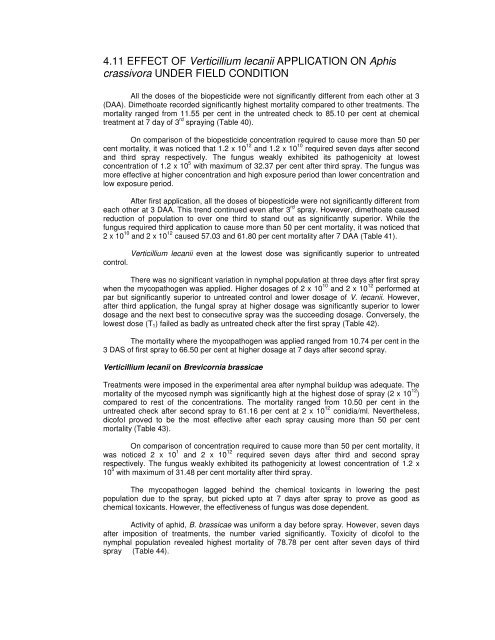ISOLATION AND CHARACTERIZATION OF ENTOMOPATHOGENIC ...
ISOLATION AND CHARACTERIZATION OF ENTOMOPATHOGENIC ...
ISOLATION AND CHARACTERIZATION OF ENTOMOPATHOGENIC ...
You also want an ePaper? Increase the reach of your titles
YUMPU automatically turns print PDFs into web optimized ePapers that Google loves.
4.11 EFFECT <strong>OF</strong> Verticillium lecanii APPLICATION ON Aphis<br />
crassivora UNDER FIELD CONDITION<br />
All the doses of the biopesticide were not significantly different from each other at 3<br />
(DAA). Dimethoate recorded significantly highest mortality compared to other treatments. The<br />
mortality ranged from 11.55 per cent in the untreated check to 85.10 per cent at chemical<br />
treatment at 7 day of 3 rd spraying (Table 40).<br />
On comparison of the biopesticide concentration required to cause more than 50 per<br />
cent mortality, it was noticed that 1.2 x 10 12 and 1.2 x 10 10 required seven days after second<br />
and third spray respectively. The fungus weakly exhibited its pathogenicity at lowest<br />
concentration of 1.2 x 10 5 with maximum of 32.37 per cent after third spray. The fungus was<br />
more effective at higher concentration and high exposure period than lower concentration and<br />
low exposure period.<br />
After first application, all the doses of biopesticide were not significantly different from<br />
each other at 3 DAA. This trend continued even after 3 rd spray. However, dimethoate caused<br />
reduction of population to over one third to stand out as significantly superior. While the<br />
fungus required third application to cause more than 50 per cent mortality, it was noticed that<br />
2 x 10 10 and 2 x 10 12 caused 57.03 and 61.80 per cent mortality after 7 DAA (Table 41).<br />
Verticillium lecanii even at the lowest dose was significantly superior to untreated<br />
control.<br />
There was no significant variation in nymphal population at three days after first spray<br />
when the mycopathogen was applied. Higher dosages of 2 x 10 10 and 2 x 10 12 performed at<br />
par but significantly superior to untreated control and lower dosage of V. lecanii. However,<br />
after third application, the fungal spray at higher dosage was significantly superior to lower<br />
dosage and the next best to consecutive spray was the succeeding dosage. Conversely, the<br />
lowest dose (T1) failed as badly as untreated check after the first spray (Table 42).<br />
The mortality where the mycopathogen was applied ranged from 10.74 per cent in the<br />
3 DAS of first spray to 66.50 per cent at higher dosage at 7 days after second spray.<br />
Verticillium lecanii on Brevicornia brassicae<br />
Treatments were imposed in the experimental area after nymphal buildup was adequate. The<br />
mortality of the mycosed nymph was significantly high at the highest dose of spray (2 x 10 12 )<br />
compared to rest of the concentrations. The mortality ranged from 10.50 per cent in the<br />
untreated check after second spray to 61.16 per cent at 2 x 10 12 conidia/ml. Nevertheless,<br />
dicofol proved to be the most effective after each spray causing more than 50 per cent<br />
mortality (Table 43).<br />
On comparison of concentration required to cause more than 50 per cent mortality, it<br />
was noticed 2 x 10 1 and 2 x 10 12 required seven days after third and second spray<br />
respectively. The fungus weakly exhibited its pathogenicity at lowest concentration of 1.2 x<br />
10 5 with maximum of 31.48 per cent mortality after third spray.<br />
The mycopathogen lagged behind the chemical toxicants in lowering the pest<br />
population due to the spray, but picked upto at 7 days after spray to prove as good as<br />
chemical toxicants. However, the effectiveness of fungus was dose dependent.<br />
Activity of aphid, B. brassicae was uniform a day before spray. However, seven days<br />
after imposition of treatments, the number varied significantly. Toxicity of dicofol to the<br />
nymphal population revealed highest mortality of 78.78 per cent after seven days of third<br />
spray (Table 44).
















